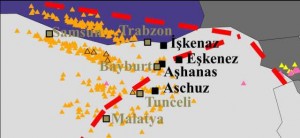
New Paper by Elhaik Shows that Ashkenazi Jews Came from Northeastern Turkey
We earlier covered the population genetics work of Dr. Eran Elhaik in “New Study Sheds Light on the Origin of the European Jewish Population”. The paper gained ‘controversial’ status for not supporting the previous claims of common origin of all Jews promoted by Harry Ostrer. Elhaik argued that the Ostrer used flawed methodology to derive his claim.

In a new paper published in Genome Biology and Evolution, Dr. Elhaik tracked down the ancient region of origin of Ashkenazi Jews using his GPS method (“New Method from Elhaik Can Find Your Ancestral Village or Island of Origin”). You can learn more about this fascinating discovery combining population genetics and linguistics from a post in his blog.
The origin of Yiddish (spoken at least since the 9th century A.D.), and consequently Yiddish speakers, has been debated for the past several centuries, mainly between linguists. While the Rhineland hypothesis suggests a German origin, the Irano-Turko-Slavic hypothesis, proposed by Paul Wexler, suggests a more complex origin starting with Slavic lands in Khazaria, followed by Ukraine, and finally Germany where the language was relexified, i.e., adopted a German vocabulary, but retained its Slavic grammar, which is why it was called Bad German.
To evaluate these two hypotheses we applied our Geographic Population Structure (GPS) tool to the genomes of over 360 sole Yiddish and non-Yiddish speaking Ashkenazic Jews. This is the largest study of Ashkenazic Jews and the first one to study Yiddish speakers. Surprisingly, GPS honed in an obscure region in northeast Turkey, with very little documented history of Jewish presence. Given the accuracy of GPS, it was a little too far away from Khazaria and too far away from the famous Babylonian schools.
Unlike other tools, GPS accepts almost no parameters that can be manipulated and those that can be tweaked did not change the results. Left with little choice, we wore our tracking shoes, packed some lunch, and went to the nearest library to dig in some old archeological and historical books.
As it turned out, we found more than we asked for. The area that GPS has identified was found to be fraught with villages (some were abandoned) whose name derive from the word Ashkenaz, suggesting that we have found ancient Ashkenaz. The search for ancient Ashkenaz has been one of the longest quests in human history (along with the search for Noahs Ark, the Ark of the Covenant, and the Lost 10 Tribes) and although further archeological evidence are necessary to prove our findings, we have a reason to be optimistic, since this is the only place in the world with placenames that derive their name from the word Ashkenaz clustered nicely along trade routes exactly what you would expect from a nation of traders. This is also where linguistic, genomic, historic, and geographic evidence converge. We can also conclude that the ancient Ashkenazic Jews were not soldiers (they left this job to the Khazars) nor scholars (they left this role to the Iranian Jews), but traders who plied land and maritime trade routes, invented a secret language with 251 words for buy and sell to maintain their monopoly, and built their township/state/kingdom in a hub of trade routes.
The paper and the abstract are reported below.
Localizing Ashkenazic Jews to primeval villages in the ancient Iranian lands of Ashkenaz
The Yiddish language is over one thousand years old and incorporates German, Slavic, and Hebrew elements. The prevalent view claims Yiddish has a German origin, whereas the opposing view posits a Slavic origin with strong Iranian and weak Turkic substrata. One of the major difficulties in deciding between these hypotheses is the unknown geographical origin of Yiddish speaking Ashkenazic Jews (AJs). An analysis of 393 Ashkenazic, Iranian, and mountain Jews and over 600 non-Jewish genomes demonstrated that Greeks, Romans, Iranians, and Turks exhibit the highest genetic similarity with AJs. The Geographic Population Structure (GPS) analysis localized most AJs along major primeval trade routes in northeastern Turkey adjacent to primeval villages with names that may be derived from Ashkenaz. Iranian and mountain Jews were localized along trade routes on the Turkeys eastern border. Loss of maternal haplogroups was evident in non-Yiddish speaking AJs. Our results suggest that AJs originated from a Slavo-Iranian confederation, which the Jews call Ashkenazic (i.e., Scythian), though these Jews probably spoke Persian and/or Ossete. This is compatible with linguistic evidence suggesting that Yiddish is a Slavic language created by Irano-Turko-Slavic Jewish merchants along the Silk Roads as a cryptic trade language, spoken only by its originators
to gain an advantage in trade. Later, in the 9th century, Yiddish underwent relexification by adopting a new vocabulary that consists of a minority of German and Hebrew and a majority of newly coined Germanoid and Hebroid elements that replaced most of the original Eastern Slavic and Sorbian vocabularies, while keeping the original grammars intact.